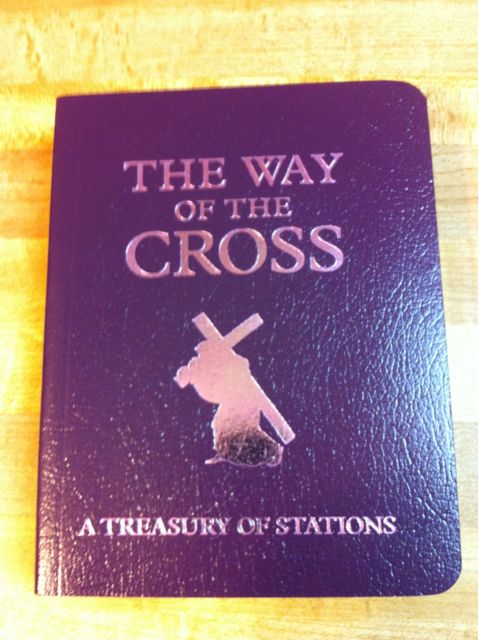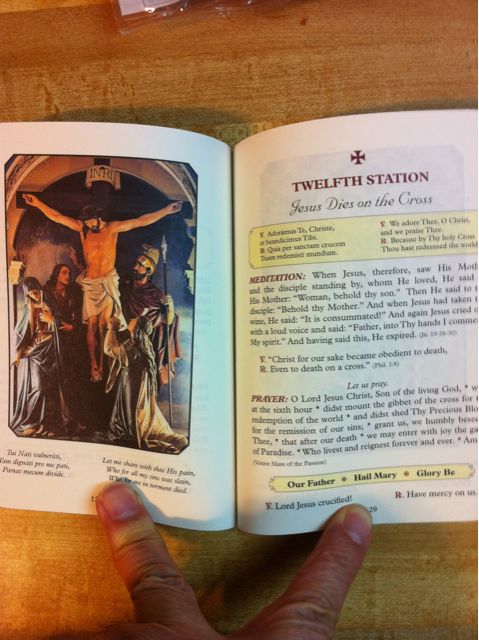From a reader:
I went to a church for Mass and Stations on my way home from work. My home parish uses the stations in the way of St. Alphonsus, but the stations at the church I visited left me with some questions, and perhaps a little confusion. According to the booklet, this Way of the Cross was developed by Pope John Paul II for Good Friday in 1991. Why were so many of the traditional stations omitted? Why did the Holy Father feel the need to add meditations that cover events beyond what is contained in the traditional Way of the Cross? [You are asking me that? Really? I hope you will have a chance to ask him that question yourself someday. o{]:¬) ] I had no luck trying to learn more in a Google search, but I was wondering if you could explain (or direct me to an explanation) of the development of John Paul’s stations. Also, is it still possible to obtain a plenary or partial indulgence with this version?
A Pope, who ultimately is the one who determines which works can gain indulgences, develops a method of the Stations of the Cross. It is celebrated publicly on Good Friday so that people participating can gain an indulgence. Is there a question about whether or not you can gain the usual indulgence for Stations using John Paul II’s method?
A plenary indulgence can be obtained by making the Way of the Cross on Good Friday even through televised participation for the Holy Father’s Stations.
Otherwise, this devotion at other times must be made before Stations of the Way of the Cross legitimately erected. That means that a bishop or his delegate is to have established them in the place, usually a church or chapel or perhaps cemetery or other outside place such as a retreat house. The bishop, etc., then provides a document that this was done. Usually a document like that, often in Latin, can be found hanging on a wall of the sacristy, unless in ignorance it was taken down.
When Stations have been duly erected, they are symbolized or “located” with a Cross on the wall or perhaps outside with a standing structure. There is often a picture or statue group, etc. There are 14 Stations. Movement from one station to the next is required when you do them as an individual. If the Stations are a public event, then just the person leading them needs to move from station to station.
The Handbook of Indulgences indicates that this is also vocal prayer. By custom some “preces vocales” are added. I suppose that might only be “Lord Jesus Crucified, have mercy on us.” Also, the Handbook says that there is flexibility about the mysteries considered.
It may be that some people are prevented from going to a church or place where there are legitimately erected Stations. In that case a person can still gain the indulgence by spending at least one half hour meditating on the Cross and death of the Lord.
Eastern Catholics, who don’t have this custom of the Way of the Cross, can also gain an indulgence according as their respective patriarchs determine.
Remember also that there are conditions for gaining any plenary indulgence. In addition to the work performed you must be free of attachment to sin. Meditation on the Cross and death of the Lord should help this resolve. Otherwise, you can gain a partial indulgence.
There is no one way by which the Way or Stations of the Cross must be observed. There are several different methods. I prefer the traditional order of the Stations, but there are others. Usually these other methods are arranged according to moments all found in the Gospels, they are scriptural-based.
As a matter of fact, I was going to post about this great little book of different observances of the Stations, an old work reprinted by Angelus Press.
These are all according to the traditional 14 Stations we are most familiar with.
John Paul II’s method in 1991 were arranged as follow:
- First Station: Jesus in the Garden of Gethsemane
- Second Station: Jesus, Betrayed by Judas, is Arrested
- Third Station: Jesus is Condemned by the Sanhedrin
- Fourth Station: Jesus is Denied by Peter
- Fifth Station: Jesus is Judged by Pilate
- Sixth Station: Jesus is Scourged and Crowned with Thorns
- Seventh Station: Jesus Bears the Cross
- Eighth Station: Jesus is Helped by Simon the Cyrenian to Carry the Cross
- Ninth Station: Jesus Meets the Women of Jerusalem
- Tenth Station: Jesus is Crucified
- Eleventh Station: Jesus Promises His Kingdom to the Good Thief
- Twelfth Station: Jesus Speaks to His Mother and the Disciple
- Thirteenth Station: Jesus Dies on the Cross
- Fourteenth Station: Jesus is Placed in the Tomb
In 2000, for the Jubilee, John Paul’s Stations were the more traditional list.




































Every church I have tried in my diocese has 15 stations, it drives me crazy. I guess they don’t want to leave us in suspense and have us wonder what happened to Jesus all during Lent.
This raises another question: In our parish we use various texts for the Stations (one for the adults and another for the children in the school). In both cases, they have the 15th station (the Resurrection). We always stop at 14. Stations are prayed before the exposed Blessed Sacrament, and Stations concludes with Benediction.
At the 12th Station (Jesus Dies), we pray an Our Father, Hail Mary and Glory Be which are not contained in the text.
My question: Is the indulgence still gained if the 15th station is eliminated from the version being prayed? Or one must pray the version as published in it’s entirety without changes or additions (such as the Hail Mary and Glory Be)?
DH and I participated in Stations last evening. It was everything I remembered from childhood, with singing, hymns in Latin, standing, kneeling, genuflecting, incense, bells and Benediction. It was the most traditional celebration I have been to in my church and the most moving.
As far as I understand, some people don’t like the traditional Stations because they are not based on the Bible. For example, there is no scriptural reference to Veronica wiping Jesus’ face. Thus, alternatives like Pope John Paul II’s 1991 list are based only on events recounted in the Gospels. I love the traditional Stations: since when do we as Catholics need a Scriptural basis for everything? ;-)
Patti Day, what you describe sounds wonderful. I was at a new church last night for Stations. There was no singing and no priest or deacon in sight. Blech.
Around where I live there seems to be a tendency to never conclude with Benediction. When I asked about it I was told “It should not be done. It is not permitted”. I raised the issue on a previous thread but there were no comments. Can anyone enlighten me if indeed it is forbidden?
The 1991 Stations of Pope John Paul II seem similar to those introduced in 1975 by Pope Paul VI — all non-Scriptural Stations have been removed.
I’ve been to some Stations of the Cross (including a ‘Living’ production done by high school students) that have an man-oriented or politicized form to them. Blech to that! Give me the traditional form of the Stations any day!
Nice book from Angelus Press, Father Z!
edm: According to the USCCB’s Committee on Divine Worship, it’s not permitted to have Stations in the Presence of the Blessed Sacrament Exposed:
“Eucharistic exposition and benediction are no longer considered devotions, but rather are a part of the Church’s official liturgy. Whereas in the past benediction was frequently added on to the end of another service or devotion, this is no longer permitted. Eucharistic exposition and benediction is a complete liturgical service in its own right and is to be celebrated as such.
“The Stations of the Cross is an ancient and venerable devotion which is designed to foster a devotion to and meditation on the mystery of the Passion of Christ. As commendable as such a devotion may be, it can never fulfill the purpose of eucharistic adoration, that is to draw us more deeply into the mystery of Christ’s presence in the Holy Eucharist. Therefore, neither the Stations of the Cross nor any other devotion should be prayed during exposition of the Eucharist.”
Here’s the full text. There doesn’t seem to be anything wrong, however, with holding Adoration and Benediction as a separate service after Stations.
First of all to gain the indulgence associated with praying the Stations, one does not even need to use written meditations — although meditations are written particularly for public use — just like praying the Rosary. In fact, one’s meditation does not need to be bound by the individual Stations. A pious meditation on the Passion of our Lord for half an hour (correct me if I’m wrong) also gains the same indulgence as making the Stations; presumably this would also include spiritual reading that has to do with the Passion.
More from the Catholic Encyclopedia:
# If a pastor or a superior of a convent, hospital, etc., wishes to have the Stations erected in their places he must ask permission of the bishop. If there are Franciscan Fathers in the same town or city, their superior must be asked to bless the Stations or delegate some priest either of his own monastery or a secular priest. If there are no Franciscan Fathers in that place the bishops who have obtained from the Holy See the extraordinary of Form C can delegate any priest to erect the Stations. This delegation of a certain priest for the blessing of the Stations must necessarily be done in writing. The pastor of such a church, or the superior of such a hospital, convent, etc., should take care to sign the document the bishop or the superior of the monastery sends, so that he may thereby express his consent to have the Stations erected in their place, for the bishop’s and the respective pastor’s or superior’s consent must be had before the Stations are blessed, otherwise the blessing is null and void;
# Pictures or tableaux of the various Stations are not necessary. It is to the cross placed over them that the indulgence is attached. These crosses must be of wood; no other material will do. If only painted on the wall the erection is null (Cong. Ind., 1837, 1838, 1845);
http://www.newadvent.org/cathen/15569a.htm